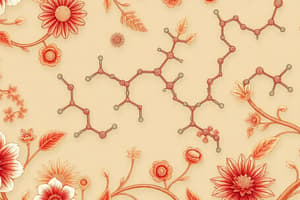Podcast
Questions and Answers
When naming alkanes with multiple substituents, how should inorganic groups be ordered?
When naming alkanes with multiple substituents, how should inorganic groups be ordered?
- Inorganic groups should be named first in alphabetical order. (correct)
- All substituents should be named in random order.
- Substituents should be listed by size, starting with the largest.
- Organic substituents should come before inorganic substituents.
What is indicated by using Greek prefixes like di, tri, and tetra in alkane nomenclature?
What is indicated by using Greek prefixes like di, tri, and tetra in alkane nomenclature?
- The number of times a substituent occurs. (correct)
- The size of the parent chain.
- The type of substituent involved.
- The position of the substituent on the parent structure.
Which rule applies when two parent chains of equal length are competing for selection?
Which rule applies when two parent chains of equal length are competing for selection?
- Choose the chain with fewer hydrogen atoms.
- Choose the chain with the greater number of substituents. (correct)
- Choose the longest chain overall, regardless of substituents.
- Choose the chain that allows for the highest substituent number.
How should numbers and names be formatted in alkane nomenclature?
How should numbers and names be formatted in alkane nomenclature?
What is the primary characteristic of cycloalkanes?
What is the primary characteristic of cycloalkanes?
What is the correct name for the compound with the formula 1,1,4-trichlorocyclodecane?
What is the correct name for the compound with the formula 1,1,4-trichlorocyclodecane?
Which statement is true regarding isomerism in organic compounds?
Which statement is true regarding isomerism in organic compounds?
What is the primary reason for the low solubility of alkanes in water?
What is the primary reason for the low solubility of alkanes in water?
Which of the following correctly identifies the physical state of C5H12 at 25 °C and 1 atm?
Which of the following correctly identifies the physical state of C5H12 at 25 °C and 1 atm?
How does branching in alkanes affect their boiling points?
How does branching in alkanes affect their boiling points?
What term describes a series of compounds where each member differs from the next by a constant unit?
What term describes a series of compounds where each member differs from the next by a constant unit?
Which type of isomerism involves compounds with the same molecular formula but different spatial arrangements?
Which type of isomerism involves compounds with the same molecular formula but different spatial arrangements?
What is the maximum number of constitutional isomers possible for C6H14?
What is the maximum number of constitutional isomers possible for C6H14?
What is the general molecular formula for alkanes?
What is the general molecular formula for alkanes?
Which of these is the simplest alkane?
Which of these is the simplest alkane?
Which of the following alkanes is NOT found abundantly in natural gas?
Which of the following alkanes is NOT found abundantly in natural gas?
What type of substituents are primarily alkyl groups?
What type of substituents are primarily alkyl groups?
Which hybridization do all carbon atoms in alkanes exhibit?
Which hybridization do all carbon atoms in alkanes exhibit?
What is the primary source of alkanes?
What is the primary source of alkanes?
How should the names of substituents be organized in relation to the parent structure?
How should the names of substituents be organized in relation to the parent structure?
What is the classification of the functional group for a carbonyl-containing compound?
What is the classification of the functional group for a carbonyl-containing compound?
Which conformation of ethane is the most stable?
Which conformation of ethane is the most stable?
What type of strain arises from eclipsed bonds in ethane?
What type of strain arises from eclipsed bonds in ethane?
Which of the following reactions can produce alkanes?
Which of the following reactions can produce alkanes?
Which statement is true regarding alkenes?
Which statement is true regarding alkenes?
What do alkyl halides commonly produce when reacted with zinc and aqueous acid?
What do alkyl halides commonly produce when reacted with zinc and aqueous acid?
What is the pKa of acetylenic hydrogen?
What is the pKa of acetylenic hydrogen?
Which type of hydrocarbons contains a double bond?
Which type of hydrocarbons contains a double bond?
What conformation of ethane is characterized by high energy and low stability?
What conformation of ethane is characterized by high energy and low stability?
What is the bond angle of the two carbon atoms in ethylene?
What is the bond angle of the two carbon atoms in ethylene?
Which suffix is used when naming alkenes?
Which suffix is used when naming alkenes?
According to Markovnikov's rule, what product is formed when propene reacts with HCl?
According to Markovnikov's rule, what product is formed when propene reacts with HCl?
What is produced when an alkene reacts with cold alkaline potassium permanganate?
What is produced when an alkene reacts with cold alkaline potassium permanganate?
Which of the following is a trivial name for the compound CH2=CH-?
Which of the following is a trivial name for the compound CH2=CH-?
How are alkenes named when they have substituents?
How are alkenes named when they have substituents?
What is the general molecular formula for alkynes?
What is the general molecular formula for alkynes?
Which of the following best describes the rotation around the double bond in alkenes?
Which of the following best describes the rotation around the double bond in alkenes?
Flashcards are hidden until you start studying
Study Notes
Functional Groups and Carbonyl Compounds
- Functional groups determine a molecule's reactivity.
- Carbonyl compounds are vital in biology and include aldehydes, ketones, and carboxylic acids.
- Key functional groups in organic chemistry include alcohols, amines, and arenes.
Alkanes Overview
- Alkanes follow the molecular formula CnH2n+2.
- Methane (CH4) is the simplest and most abundant alkane; followed by ethane (C2H6) and propane (C3H8).
- Natural gas consists of approximately 75% methane, 10% ethane, and 5% propane.
- Liquefied petroleum gas (LPG) is mainly a propane-rich hydrocarbon mixture.
Structure and Nomenclature of Alkanes
- Alkanes feature sp3-hybridized carbon atoms with σ bonds arranged in a tetrahedral configuration.
- Nomenclature rules include identifying the longest carbon chain and naming substituents accordingly.
- Different types of substituents include inorganic (e.g., bromo, chloro) and organic (e.g., methyl, ethyl).
- Substituents are numbered to indicate their position, using the lowest possible numbers.
Cycloalkanes
- Cycloalkanes are saturated cyclic hydrocarbons with the formula CnH2n.
- Naming begins at the point of attachment to ensure priority for substituents.
- Example compounds include 1,1,4-trichlorocyclodecane and trans-1-bromo-3-ethylcyclohexane.
Isomerism in Alkanes
- Isomerism allows compounds with the same molecular formula to have different structural properties.
- Alkanes with four or more carbons exhibit constitutional isomerism, such as n-butane and isobutane.
- C5H12 has three isomers: n-pentane, iso-pentane, and neo-pentane.
Physical Properties of Alkanes
- Alkanes show a consistent increase in boiling points with rising molecular weights.
- Unbranched alkanes with 1-4 carbons are gases at 25°C, whereas those with 5-17 carbons are liquids, and those with 18 or more are solids.
- Alkanes are insoluble in water due to their inability to form hydrogen bonds, but are soluble in low polarity solvents.
Conformation and Stability of Alkanes
- Conformations reflect different spatial arrangements caused by rotation around single bonds, with ethane showing staggered (more stable) and eclipsed (less stable) arrangements.
- Torsional strain arises from eclipsed bonds, while steric strain refers to spatially dependent interactions.
Chemical Reactions of Alkanes
- Alkanes can react with halogens (chlorine and bromine) when heated.
- Hydrogenation converts alkenes and alkynes to alkanes using metal catalysts like nickel or palladium.
- Reduction of alkyl halides and alkylation of terminal alkynes are other synthesis methods for alkanes.
Alkenes Overview
- Alkenes are hydrocarbons containing one double bond, with the general formula CnH2n.
- They are more reactive than alkanes due to the presence of a double bond.
- The structure results in sp2 hybridization and a bond angle of 120°.
Nomenclature and Reactions of Alkenes
- Alkenes are named by identifying the longest chain containing the double bond, changing the "ane" ending to "ene."
- Hydrogen halides add to alkenes to form alkyl halides, with products determined by Markovnikov’s Rule.
- Oxidation of alkenes yields 1,2-diols when reacted with alkaline potassium permanganate or osmium tetroxide.
Alkynes Overview
- Alkynes are unsaturated hydrocarbons characterized by one or more triple bonds, adhering to the formula CnH2n−2.
Studying That Suits You
Use AI to generate personalized quizzes and flashcards to suit your learning preferences.



